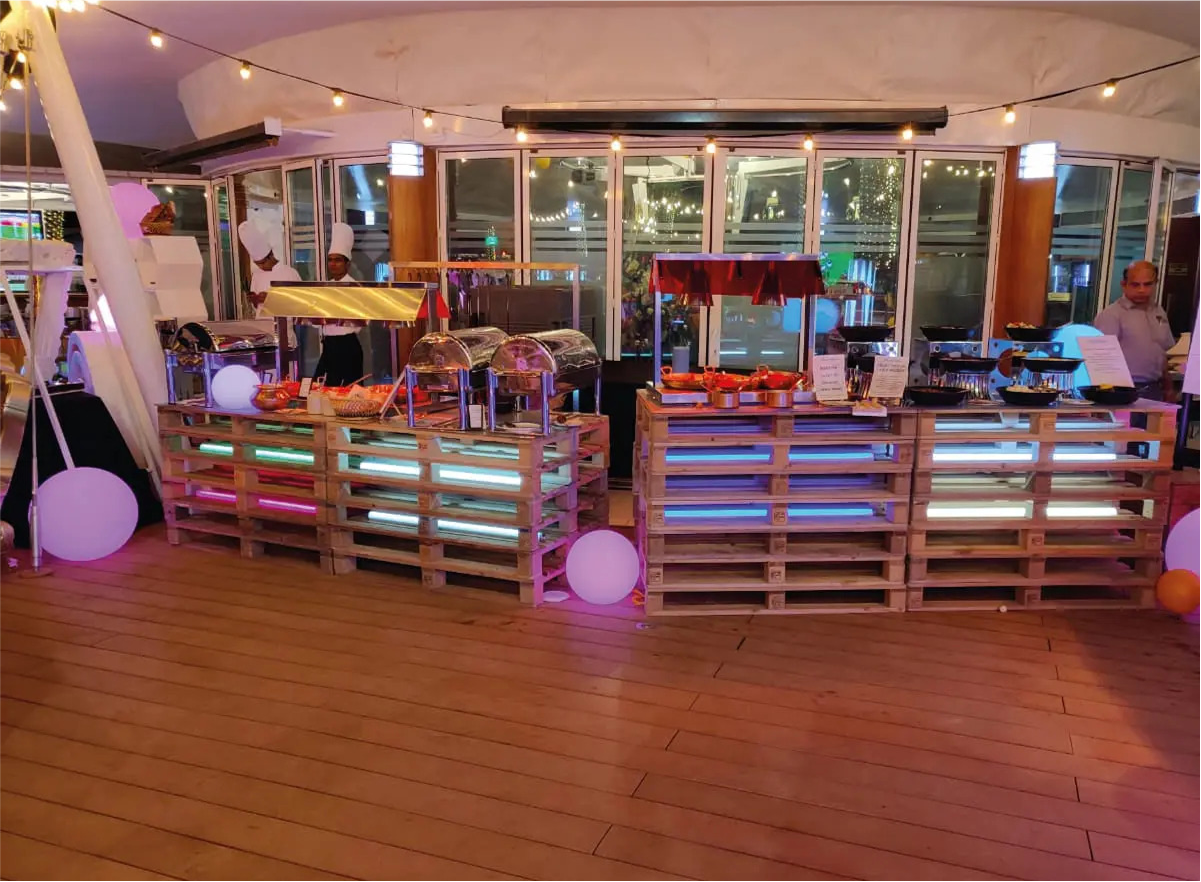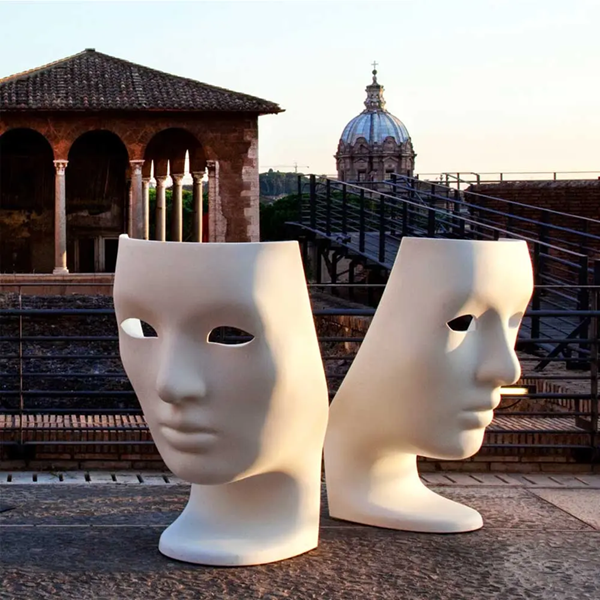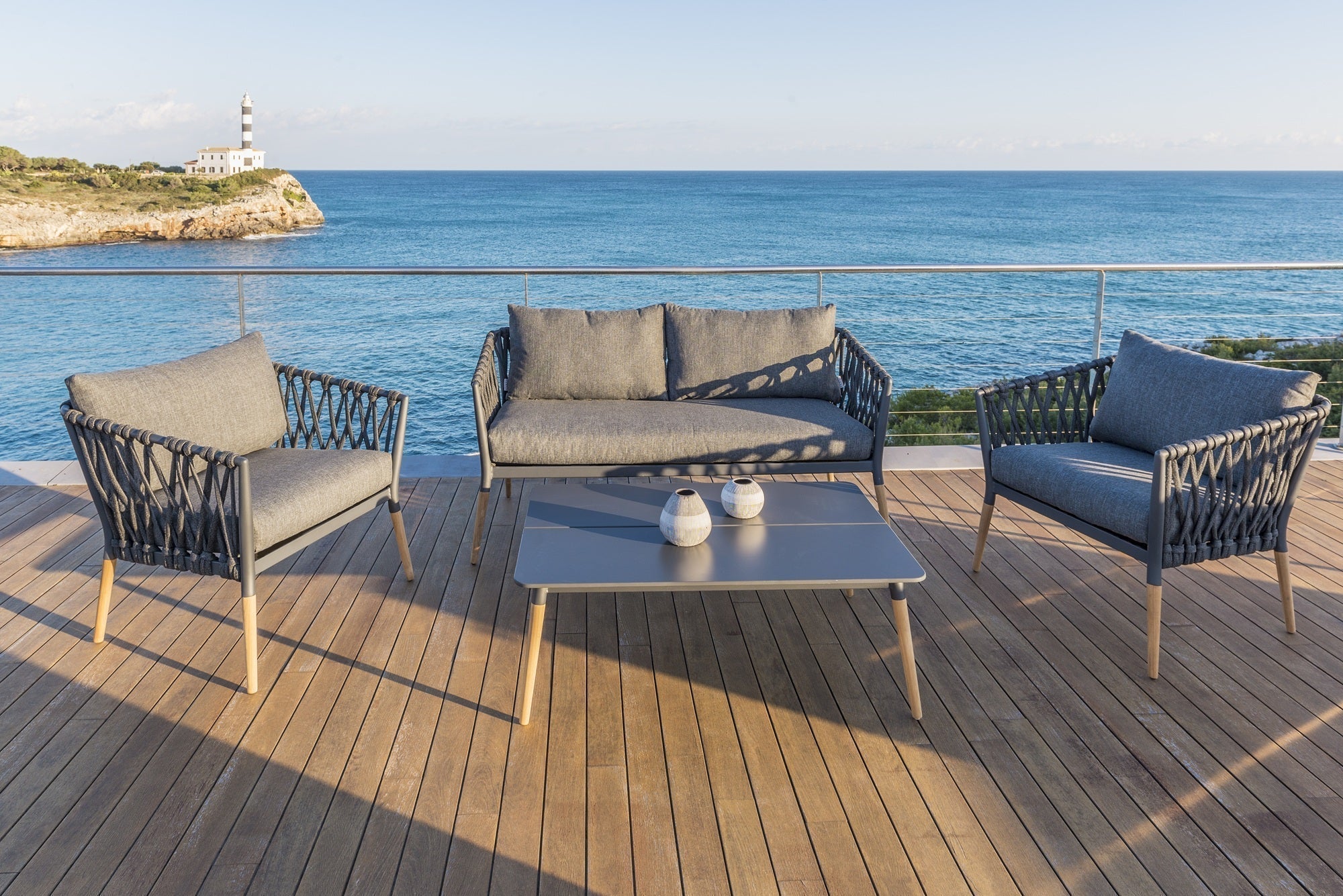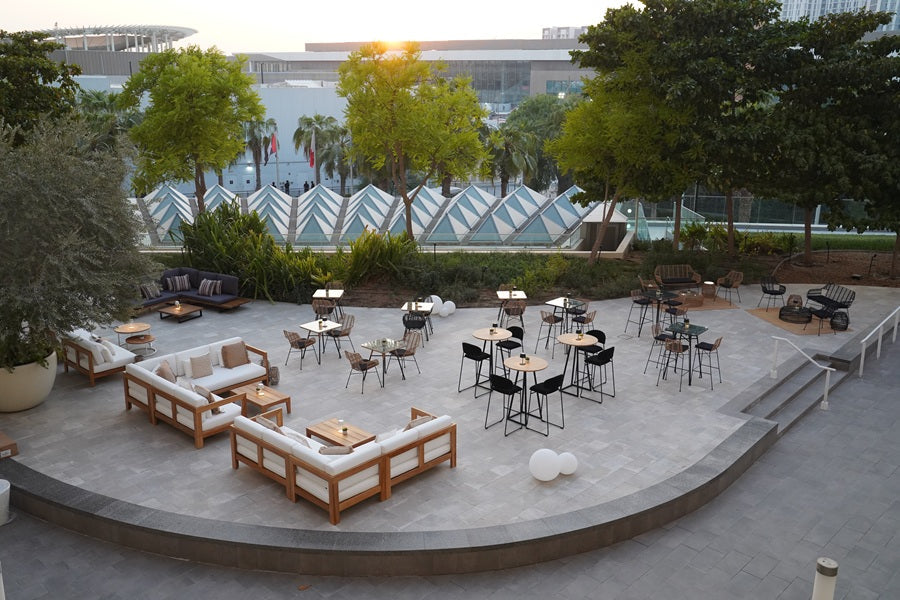When you're planning an event, how and where the food is served can make a big difference. Buffet-style dining has become a popular choice because it's flexible, efficient, and gives guests the freedom to choose what they like.
Beyond practicality, the buffet table itself can become a standout feature of your event. With a bit of planning, it can reflect the theme and even become a talking point. Whether you’re planning a wedding, corporate gathering, or private party, a thoughtful buffet layout is something that shouldn’t be overlooked.
Choosing the Best Buffet Setup Layout for Your Venue
Every event is different, and the way you set up your buffet should match the space, style, and number of guests. A good buffet table keeps the food looking neat, and fits well with the overall design of your event.
Below are four popular buffet setup layout styles. Each one has its own strengths depending on your event type and venue.
4 Styles of Buffet Table Layout
1. Single-line
A single-line layout is simple and works best for smaller events. One long table holds all the food, and guests move from one end to the other in a straight line. Plates are placed at the start, and cutlery is usually at the end.
Single-line setup is easy to manage, and it works well when space is limited. However, it can lead to queues, so it’s not ideal for large crowds. To make it more interesting, consider adding height with display risers or small table accents to break up the line visually.
2. Double-sided
A double-sided buffet layout uses the same long table but allows guests to serve themselves from both sides
It’s a great option for medium to large events, especially when you expect a big guest turnout. This layout also gives you more space to display food in creative ways, such as grouping items by type (salads on one side, mains on the other). For even more efficiency, consider placing matching displays on both sides.
3. U-shaped
The U-shaped layout features three connected tables forming the shape of a “U”. Guests enter from one end and work their way around. It creates a more contained and controlled flow. It’s perfect when you have a central area to fill or want the buffet to feel like a feature in the room.
U-shaped setups allow you to create themed sections. For example, appetisers on one side, hot dishes at the back, and desserts on the other.
It also gives space behind the table for staff to restock or support the service discreetly.
4. Circular or island style
The circular layout uses round tables or a central “island” in the middle of the room, allowing guests to walk around all sides.
It’s ideal for casual, social events where people are moving freely and mingling. It works particularly well in outdoor settings, cocktail-style events, or when food stations are spread across the space.
You can place different food categories on each side, or create a themed station, like a salad bar or dessert corner. If your event design leans modern, an island-style buffet table with layered dishes and soft lighting can create a striking focal point.
Tips on Selecting the Right Buffet Layout for Different Spaces
Choosing the right layout depends on your space, guest number, and event style. Here are a few helpful tips:
-
Small venues: Go with a single-line or island setup to keep things simple and avoid crowding.
-
Large guest lists: Use double-sided or U-shaped layouts to speed up the flow and keep things moving.
-
Outdoor events: Island-style or circular layouts make the most of open space and encourage guests to move around.
-
Formal or themed events: U-shaped layouts allow more control over the look and order of the buffet.
-
Limited staff support: Keep layouts straightforward, with clear flow and easy access for guests.
By matching your layout to your space and event needs, you’ll create a buffet that looks good, works smoothly, and keeps your guests happy.

Step-by-Step Buffet Table Arrangement Ideas
A buffet table should be easy to follow, tidy, and pleasant to look at. When food is arranged in the right order, it helps guests move smoothly, keeps the table organised, and makes the whole experience feel more enjoyable.
1. Start with Plates and Bowls
Begin your buffet table with a clear starting point. This is where you place the plates, bowls, and sometimes serving trays. Use a neat stack or a stylish holder to keep things tidy.
If space allows, include napkins here too or save them for the end of the line to avoid guests holding too much at once. By placing the plates at the start, you help guests know exactly where to begin.
2. Progress to Salads and Cold Dishes
After the plates, lead into the lighter, cooler items. Start with fresh salads, dips, breads, or cheese platters. These are usually easy to serve and don’t need to stay hot, so they can sit out for longer.
Using risers or trays at different heights adds visual interest and makes each item easy to reach. It’s also a nice way to break up the line and make the table look more inviting.
3. Follow with Mains and Hot Dishes
Next, move into the main course area. This includes your warm dishes like pasta, grilled meats, rice, or vegetables. Use chafing dishes or warmers to keep food at a safe and pleasant temperature.
Place heavier, messier foods in dishes with sides to help prevent spills. If the buffet table layout is against a wall, put taller items at the back and flatter dishes in front so guests can see everything clearly.
4. Place Condiments and Sauces Mid-Way
In between or right after the mains, include a section for condiments and sauces. This could be dips, dressings, or toppings like herbs, grated cheese, or chilli oil.
Keep these in small bowls or jars with proper spoons or ladles. Group them close to the food they go with so guests don’t have to search. A tidy sauce section keeps the table clean and makes it easier for everyone.
5. End with Desserts and Beverages
Finish your buffet line with sweet items and drinks. Desserts might include mini tarts, cakes, puddings, or fruit platters. Keep portion sizes small and easy to pick up.
Drinks, like infused water, juices, or tea, can be placed beside or behind the dessert area. If your space allows, you can also set up a separate drinks station to reduce crowding.
Using cake stands, crates, or tiered trays creates a more dynamic buffet table arrangement and helps highlight this final section.
6. Label Every Dish Clearly
Guests with dietary needs or allergies rely on good signage to make safe choices.
Use small tent cards, wooden pegs, chalkboards, or printed signs that suit the event’s style. Keep the names simple and add any key details (like contains nuts or gluten-free) in a smaller line underneath.
Also make sure labels are easy to read, especially for dim lighting; you might even include buffet table lights or small LED spotlights for evening events.

How to Use Buffet Table Lights to Enhance Visibility and Atmosphere
Lighting shapes how guests see and experience a buffet. It not only sets the mood but also makes food and signage more appealing and accessible.
Consider Time and Venue
For evening or dimly lit venues, soft, warm lighting helps create a welcoming glow while ensuring food and signage are easy to read. If you're using printed or handwritten dish labels, small clip-on or under-table lights can gently highlight them without overpowering the decor. It’s also a good idea to test the lighting around the same time you plan to start and end the event, especially outdoors, where natural light can shift quickly.
Add Depth and Ambience
Uplights or LED strips under the buffet table can create a soft halo effect, adding depth and warmth to the setup. Buffet table lights like fairy lights, pendant bulbs, or battery-operated lamps can also be woven into the event theme. For outdoor events, hanging lights within parasols or canopies can be both practical and decorative.
When used thoughtfully, lighting highlights the buffet, guides guests with ease, and enhances the atmosphere, transforming the dining experience into something truly memorable.
Buffet Table Arrangement Ideas for Different Event Types
Not every buffet needs to look or feel the same. The type of event often shapes the layout, furniture choice, and even the way food is displayed. Here are a few tailored buffet table arrangement ideas based on different event styles:
Weddings
Weddings often call for an elegant, soft, and romantic approach. Use long tables with flowing linens and subtle lighting to match the wedding theme. Tiered dessert stands, floral runners, or candles can add character without taking up too much space.
For the layout, a double-sided or U-shaped buffet works well for larger guest lists, helping guests move through with ease. A separate drinks station or bar area near the buffet keeps things from getting too crowded.
Furniture tip: Consider lounge seating nearby, or use decorative backdrops and parasols to frame the buffet table and make it part of the event design.
Corporate Events
Here, the focus is usually on function and flow. A clean, professional setup helps guests move quickly and easily. Use clear signage, neatly labelled dishes, and a buffet table layout that suits the event duration. For example, single-line for small meetings or double-sided for busy conferences.
Neutral tones with a few brand-aligned touches (such as logos on food cards or matching napkins) can reinforce the company’s image without feeling too formal.
Furniture tip: Sleek bar tables or high stools nearby offer a space for informal chats during breaks or networking moments.
Outdoor Parties
Outdoor events allow for more flexibility, but they also come with a few extra things to consider. Go for durable materials, wind-resistant décor, and serving items that stay in place. A circular or island-style buffet works beautifully here, giving guests access from all angles and encouraging movement.
For garden parties or beachside gatherings, you can add charm with lanterns, rustic crates, or small floral arrangements. Keep food shaded and well-lit with table lights built into parasols or temporary structures.
Furniture tip: Use shaded cabanas, mobile counters, or weatherproof high tables to frame your buffet area and offer guests relaxed dining spots.
Festivals or Themed Events
This is where you can have fun with bold ideas and creative styling. Use props, colours, and themed serveware that reflect the event’s personality, whether it’s a retro food truck setup, carnival station, or a cultural celebration.
Multiple smaller buffet stations work well here, especially when offering different cuisines or food types. Mixing layouts, like a few island tables and one central U-shaped setup helps guests explore without crowding one area.
Furniture tip: Food trucks, party vehicles, or pop-up bars can be part of the buffet setup, blending function with décor.

Practical Tips for Buffet Setup at Outdoor Venues
Outdoor events have a special charm, but they also need a bit more planning, especially when it comes to food service. Weather, lighting, and surface conditions can all affect your buffet setup. These simple, practical tips will help ensure your buffet table stays safe, stylish, and easy to manage.
Use of Canopies or Parasols
Shade and shelter are essential for any outdoor buffet. Canopies, stretch tents, or large parasols not only protect the food and guests from sun or light rain, but they also help frame the buffet space and make it feel like part of the overall design.
For evening events, consider using parasols or structures with built-in buffet table lights to maintain visibility as the sun goes down. This also ensures food labels and serving stations stay easy to navigate after dark.
Weighted Serveware and Linens
Outdoor conditions often mean wind, and wind can quickly turn napkins, lightweight trays, or cloths into flying hazards. Choose serveware with a bit of weight or grip, and use clips, ties, or discreet weights to keep linens and runners in place.
Avoid delicate centrepieces or overly tall displays that could topple. Instead, go for low, stable accents like wooden risers, weighted jars, or heavy ceramic platters.
Keeping Food Covered and Protected
Keeping food fresh and safe outdoors is key. Use domed lids, covers, or display boxes to shield items from insects, dust, and the elements. This is especially important for sweet or sticky dishes, as well as anything sitting out for longer periods.
Consider placing cold items in chilled trays or on ice beds. For hot dishes, use warmers with lids that are easy for guests to lift and replace.
If space allows, a small shaded prep table behind the buffet can help with quick restocking without disrupting the main setup.
Final Buffet Setup Checklist for Event Planners
Before guests arrive, do one final walk-through of your buffet setup layout using this quick checklist. It’ll help you catch any last-minute issues and ensure everything runs smoothly once service begins.
-
Plates, bowls, napkins, and cutlery are placed in logical order (plates at the start, cutlery at the end)
-
Dish labels are clear, easy to read, and include allergen or dietary info where needed
-
Buffet table lighting is in place, especially for evening or outdoor events
-
Tables are stable, level, and accessible from the right sides for guest flow
-
Emergency extras are ready: spare napkins, extra serving spoons, bins for waste, and wipes for any spills
-
Check food temperatures and covers before guests arrive
Taking five minutes to double-check the setup can save you from issues later and help your team stay one step ahead.

Make Your Buffet Table the Highlight of the Event
A well-planned buffet setup layout brings structure, style, and a sense of ease to your event. From the way the food is arranged to the lighting, furniture, and final touches, every element plays a role in shaping the experience.
Whether you're working in a grand ballroom, a garden, or a rooftop terrace, a buffet can be both practical and beautiful. With thoughtful layout choices, subtle lighting, and the right mix of furniture and décor, your buffet table can become a true highlight, one that also sets the tone for the entire event.
Frequently Asked Questions
What is the most space-efficient buffet setup layout for events in Dubai?
For events with limited space, a single-line buffet layout is often the most efficient option. That said, if you’re hosting more guests, a double-sided layout can help reduce queues without needing more floor space. We often recommend folding buffet tables or compact modular counters that adapt well to different venues across the UAE, especially indoors or in hotel ballrooms.
How do I keep food stations cool or warm during outdoor events in the UAE?
Given the UAE’s climate, temperature control is essential. For outdoor setups, we suggest using covered chafing dishes for hot food and ice trays or insulated containers for cold items. Keep dishes shaded under parasols or tented structures to avoid direct sun. At Desert River, we also offer weather-resistant buffet furniture and covered counters that help maintain safe serving conditions without compromising style.
Are there rules around buffet table setup for events in public venues or hotels in the UAE?
Yes, most venues in the UAE, especially hotels and licensed event spaces have specific guidelines. These often include food safety standards (such as covering food and providing sneeze guards), hygiene rules, and layout approval from venue management.
What’s the best buffet table layout for a multicultural guest list?
When catering to diverse tastes, common in UAE events, a U-shaped or island-style buffet layout works well. It allows you to divide the table into zones: for example, vegetarian, meat-based, or regional cuisines.
How do I integrate lighting into a buffet setup without power access outdoors?
For evening outdoor events or beach settings, we recommend battery-powered or solar buffet table lights. These are ideal for lighting food stations, signs, and decorative areas. At Desert River, we offer, cordless lanterns, and light-up buffet tables that provide both function and ambience, no power cables needed.








